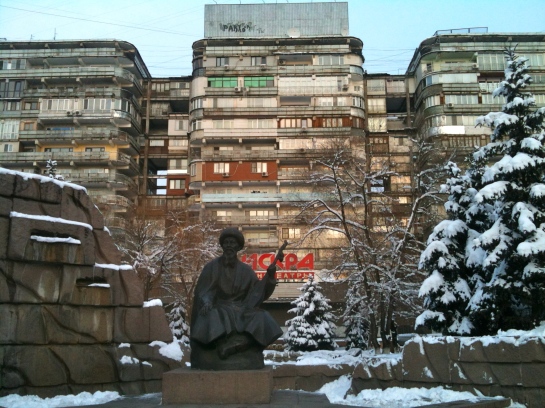
A late-Soviet era residential building in downtown Almaty with a statue to a Kazakh folk hero out front
Central Asia, and especially Kazakhstan, was effectively a testing ground for Soviet experiments of all sorts. This is most tragically the case with regards to weaponry and military capability. Until the souring of relations with China, Soviet Central Asia was an inland fortress, protected by natural and political defenses on all sides. Eastern Kazakhstan was therefore selected to host the Soviet nuclear testing site: the “Polygon” zone saw some 450 nuclear explosions, only 350 below ground, several in the atmosphere. In the country’s west, the ironically-named Vozrozhdeniye (Renaissance) island in the Aral Sea was used to test biohazardous material, including weaponized anthrax.
As a testing site, the Kazakh Soviet Socialist Republic had the advantage of being huge, mostly unpopulated and undeveloped in a traditional sense. But besides being protected, isolated and “empty,” it was also politically a safer place in which to conduct experiments. As one friend of mine here argued, despite rhetoric about the brotherhood of nationalities, Russians did not care about the well-being of the nomadic, uncivilized and subjugated Soviet Kazakhs. If a bomb goes off on the steppe and no one important hears it, does it make a sound?
And Moscow’s exploitation of the Kazakh SSR extended far beyond weapons testing. In no particular order, this was also the site of Khrushchev’s Virgin Lands campaign in the 1950s – an attempt to transform huge areas of unproductive land into wheat and cotton fields through massive irrigation efforts and agricultural pseudo-science; experiments in the economics of penal labor – Karaganda, in northern-central Kazakhstan, was the site of the largest single camp in the system of correctional labor facilities popularly called the “gulag”; and aerospace technology – the Baikonur space center, in south-central Kazakhstan, was the heart of the Soviet space program.
I recently read a 1995 article by one Prof. Paul Josephson of Sarah Lawrence College about the Soviet penchant for giant infrastructural projects (“Projects of the Century in Soviet History: Large-Scale Technologies from Lenin to Gorbachev,” Technology and Culture Vol. 36, No. 3, June 1995). As Josephson points out, there were economic, political and popular incentives to undertake large-scale, unsound projects built into the Soviet system. In a system where “costs” are notionally non-existent but unemployment is a pressing problem, firms choose projects that engage the maximum number of resources. These were also prestige projects. The culture of reckless experimentation is explicable by similar logic.
But not all testing in Central Asia was so dramatic or devastating. Largely undeveloped until after the Second World War, Almaty was also a natural location in which to conduct urban planning experiments. Leftist architectural theory was strong throughout Soviet history, as even space itself would shape the evolution of homo Sovieticus, but it was hard to test theories in developed cities. According to Catherine Alexander, Dinmukhammed Kunayev’s tenure (1960-1986) coincides with Almaty’s “golden age” of urban development and expansion, necessitated in part by the flood of migrants from Khrushchev’s marginally viable Virgin Lands campaign further north (“Soviet and Post-Soviet Planning in Almaty, Kazakhstan,” Critique of Anthropology, Vol. 27, No. 165, 2007).
In ecological terms the effects were disastrous, but in urban planning and architectural terms alone, the results are mixed. A handful of massive vaguely neoclassical show-piece buildings (the opera, the Academy of Sciences) are framed by popular thoroughfares to theatrical effect. Although locals call these buildings “beautiful,” I think they do so by rote. More to my taste (although “interest” is a better word) are the late 1970s-80s apartment buildings sprinkled around the city.
People have told me that my appreciation of these buildings is “ironic,” that I “cannot be serious.” But I am. I like these buildings in the same why I appreciate most art: they’re ghastly, sure, but they reflect a real, if distorted, utopian social project. They are genuine historical artifacts. The modularity, the concrete-slab construction, the function-over-form, the (failed) space-age aesthetic mark these buildings as the very real manifestations of the theoretical principles of 1960s-80s Continental social theorists. They are Frankenstein’s monsters, and they have infinitely more character than the shiny New York skyscraper in which I used to work.
All of this raises another question: What does it do to a nation to exists among the detritus of failed experiments? How does living amongst the wreckage of so many high modernist projects-run-aground impact the social and individual psyche?
It does not appear to dissuade the inheritors from undertaking their own massive pipe-dream “projects of the century,” as a recent National Geographic article about Astana makes clear. I can recommend this article for the pictures, but I will warn that almost nothing written by the journalist meshes with what I’ve heard about Astana.





